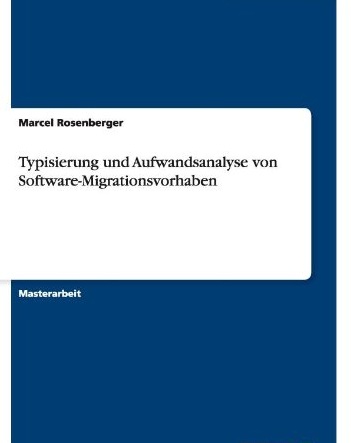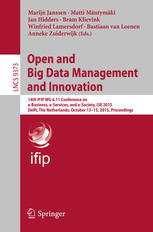Publikationen
Seitenübersicht
- Software-Migrationen: Aufwandsabschätzung für die Ablösung von Altsystemen
- Typisierung und Aufwandsanalyse von Software-Migrationsvorhaben
- Conceptualising and Exploring User Activities in Social Media
- Social Customer Relationship Management: An Architectural Exploration of the Components
- Ein Datenmodell zur Unterstützung der Datenintegration von Nutzeraktivitäten aus verschiedenen sozialen Netzwerken
- A System Architecture for Integrating User Activities in Social Networks with Customer Relationship Management
- Integrating data from user activities of social networks into public administrations
Software-Migrationen: Aufwandsabschätzung für die Ablösung von Altsystemen
von Marcel Rosenberger (Autor)
Abstract. Existierende IT-Systeme in Unternehmen bilden häufig eine heterogene Landschaft und sind historisch gewachsen. Aus Kostengründen werden bestehende Systeme nicht immer rechtzeitig reformiert oder ersetzt.
Die Software-Migration hat die Überführung eines Systems in eine veränderte Umgebung zum Gegenstand. Im Unterschied zur klassischen Neuentwicklung existiert ein System, das bereits die gewünschten fachlichen Anforderungen erfüllt. Durch den schnellen technologischen Wandel ist die zu migrierende Software zu einem Altsystem geworden und hemmt Unternehmensprozesse. Da die Funktionalität nicht neu entwickelt werden muss, ist die Software-Migration oftmals eine kostengünstigere und risikoärmere Alternative zur Neuentwicklung. Damit beginnt das Projekt allerdings nicht „auf der grünen Wiese“, sondern wird durch Eigenschaften des Altsystems (auch negativ) beeinflusst.
Die Durchführung der Migration erfordert Ressourcen, für deren Beschaffung und Verwendung Aufwand entsteht. In diesem Buch werden Typen von Migrationen unterschieden und ein Scoring-Modell entwickelt, dass die Aufwandsabschätzung von Migrationen ermöglicht.
Taschenbuch:
128 Seiten
Verlag:
Diplomica Verlag; Auflage: 1., Aufl. (14. Oktober 2013)
Sprache:
Deutsch
ISBN-10:
384288611X
ISBN-13:
978-3656476931
Typisierung und Aufwandsanalyse von Software-Migrationsvorhaben
von Marcel Rosenberger (Autor)
Taschenbuch:
100 Seiten
Verlag:
Grin Verlag GmbH (10. August 2013)
Sprache:
Deutsch
ISBN-10:
3656476934
ISBN-13:
978-3656476931
Conceptualising and Exploring User Activities in Social Media
von Marcel Rosenberger, Tobias Lehmkuhl, Reinhard Jung (Autoren)
Abstract. A growing number of companies are recognising the benefits of using social media in customer relationship management. At the same time, the consumers’ expectations are rising: short response times, individual communication, real interaction with humans, and participation. It is a challenge to observe the many different user activities on many different social media sites. The aim is to reduce the complexity of integrating multiple social media sites with enterprise systems. Therefore, a conceptualisation of user activities in social media is presented. A user activity is a cross-over of an action invoked on an object and a user who acts in a certain context. The 40 user activity types are compared with actual features of ten social media sites. We find out that a substantial share of them can be integrated technically using the social media site’s Application Programming Interfaces (APIs).
Keywords: social media, user activities, conceptualisation, integration.
Konferenzbeitrag:
Open and Big Data Management and Innovation - 14th IFIP WG 6.11 Conference on e-Business, e-Services, and e-Society, I3E 2015, Delft, The Netherlands, October 13–15, 2015, Proceedings
Verlag:
Springer
Sprache:
Englisch
ISBN (Print):
978-3-319-25012-0
ISBN (Online):
978-3-319-25013-7
Social Customer Relationship Management: An Architectural Exploration of the Components
von Marcel Rosenberger (Autor)
Abstract. In the recent years, social media have rapidly gained an increasing popularity. Companies have recognised this development and anticipate advantages from using social media for commercial purposes. Social customer relationship management (CRM) professionalises the use of social media and aims at integrating customers into operational procedures. This induces changes of existing structures, e.g. culture and organisation, business processes, information systems (IS), data structures, and technology. The intended transformation from CRM to social CRM is a complex task, because different aspects are affected, which also are mutually dependent. A prerequisite for the successful implementation of social CRM is understanding these aspects and its dependencies. Separation of concerns is a useful means of addressing complexity. The conglomeration of different issues is dissolved by conceptualising components and its relationships. This paper separates the concerns of social CRM using architectural perspectives and aims at building a better understanding. The research method is a literature review in which artefacts are gathered and assigned to five layers, which are business, process, integration, software, and technology. The conclusion states that social CRM is an emergent research field and comprises a call for more artefacts that concretise abstracted components of the business-layer.
Keywords: Social CRM, design science, Enterprise Architecture, artefacts, literature review.
Konferenzbeitrag:
Open and Big Data Management and Innovation - 14th IFIP WG 6.11 Conference on e-Business, e-Services, and e-Society, I3E 2015, Delft, The Netherlands, October 13–15, 2015, Proceedings
Verlag:
Springer
Sprache:
Englisch
ISBN (Print):
978-3-319-25012-0
ISBN (Online):
978-3-319-25013-7
Ein Datenmodell zur Unterstützung der Datenintegration von Nutzeraktivitäten aus verschiedenen sozialen Netzwerken
von Marcel Rosenberger, Christiane Lehrer und Reinhard Jung (Autoren)
Abstract. Durch die Integration von Daten aus sozialen Netzwerken und Informationssystemen (IS) im Unternehmen können betriebliche Abläufe verbessert werden, indem neue und relevante Informationen über Kunden/Konsumenten zur Verfügung stehen und Prozesse durch Automatisierung beschleunigt werden. Das Forschungsziel des vorliegenden Beitrags ist die einheitliche Datenintegration von Nutzeraktivitäten verschiedener sozialer Netzwerke mit IS im Customer Relationship Management. Der Ergebnistyp ist ein Datenmodell für Nutzeraktivitäten, welches auf vorhandenen Konzepten basiert und nach gestaltungsorientiertem Forschungsansatz entwickelt wurde. Die Konkretisierung durch die Sicht auf die Daten, erweitert die wissenschaftliche Perspektive und ermöglicht die Implementierung einer Integrationslösung. In einem Softwareprototyp wurde das Datenmodell in einem Anwendungsfall erprobt und dafür verwendet, die unterschiedlichen Datenstrukturen der sozialen Netzwerke LinkedIn, Facebook und Twitter zu vereinheitlichen, um Nutzeraktivitäten plattformunabhängig zu filtern. Die generelle Praxistauglichkeit des Datenmodells in anderen Anwendungsfällen muss künftig durch weitere Einsätze aufgezeigt werden.
Konferenzbeitrag:
Business Intelligence, Analytics und Big Data. Multikonferenz Wirtschaftsinformatik (MKWI) 2016
Verlag:
Universitätsverlag Ilmenau
Sprache:
Deutsch
ISBN (Print):
978-3-86360-132-4
A System Architecture for Integrating User Activities in Social Networks with Customer Relationship Management
von Marcel Rosenberger, Christiane Lehrer und Reinhard Jung (Autoren)
Abstract. Companies have long recognised that their participation in social networks is expected by existing and new potential customers, who request support, provide feedback to products they own, post complaints and exchange views about the company, for example. Information systems are required for identifying relevant user activities that must be dealt with in a given time. Therefore, existing social media tools provide analytical functions. The integration of these tools and/or social networks directly with Customer Relationship Management (CRM) systems, however, is still sparse. We propose a system architecture for integrating user activities in social networks with CRM, which describes eight subsystems and serves as a construction plan to implement an integration software. The research follows the process of a design science research and includes proposed components of related system models from existing literature. Parts of the architecture have been evaluated in the context of a software-prototype that creates opportunity-tickets based on new posts, and thereby triggers the lead management process of a consulting company.
Konferenzbeitrag:
Modellierung betrieblicher Informationssysteme - Konzeptuelle Modelle im Zeitalter der digitalisierten Wirtschaft (d!conomy). Multikonferenz Wirtschaftsinformatik (MKWI) 2016
Verlag:
Universitätsverlag Ilmenau
Sprache:
Englisch
ISBN (Print):
978-3-86360-132-4
Integrating data from user activities of social networks into public administrations
von Marcel Rosenberger, Christiane Lehrer und Reinhard Jung (Autoren)
Abstract. Linking social networks with government applications promises various benefits, such as improving citizens’ public engagement, increasing transparency and openness in government actions, and new or enhanced government services. The research goal is to drive innovation in governments through the integration of user activities from social networks into government applications. Instead of using third-party social media tools, we call for self-developing integration software, so that the government retains full control of the sensitive government data that is linked to social network user data. Following a design science approach, we developed a data model of user activities in social networks. Our 40 user activity types conceptualize the common fundamental data structure and are a means for comparing current features of ten prominent social networks. We find that a substantial share of user activities can be mutually integrated by wrapping social network Application Programming Interfaces (APIs).
Keywords: social networks, user activities, integration, open data, government.
Journal Artikel:
Information Systems Frontiers - A Journal of Research and Innovation, Volume 19, Number 2, 253–266 (2017)
Verlag:
Springer
Sprache:
Englisch
ISBN (Print):
1387-3326




